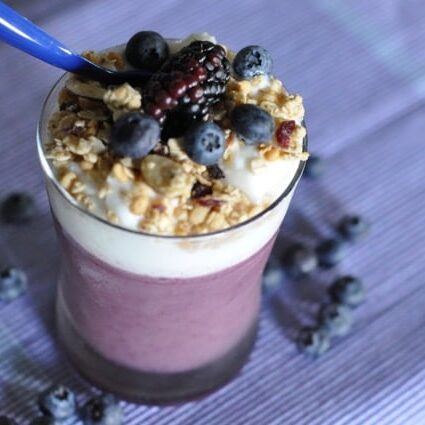Is there such a thing as healthy ice cream?
Thank you to my friends at Alberta Milk for partnering with me to bring you this sponsored blog post, helping you energize your nutrition, one bite at a time.
Is there such a thing as healthy ice cream? Is frozen yogurt a healthier choice than ice cream? What about sherbet, sorbet or gelato – are they okay? These are the questions my husband peppered me with last week. Simple questions without simple answers.
The concept of what makes a food “healthy” is not black and white. We all have different criteria we use to evaluate the healthiness of a food.
1) Nutrition of ice cream
For some people, the nutrition of a food determines whether they evaluate it as “healthy”. This approach to gauging the healthiness of a food often places more value on having fewer calories, less “negative” nutrients (nutrients that we may want to limit like sugar, fat, sodium) and having more “positive” nutrients (nutrients we may want to increase like vitamins, minerals, low glycemic index carbohydrates, fiber, protein, healthy fats). An entire field of research called nutrient profiling is dedicated to devising a system for rating foods based on their nutritional value.
So for example, have a look at how ice cream and other frozen summer foods vary based on their calories and amount of sugar.
| Calories* per ½ cup | Sugar* (g) per ½ cup | |
| Ice cream vanilla | 137-266 | 15-22 |
| Frozen yogurt | 100 | 14 |
| Sherbet, rainbow | 120 | 26 |
| Sorbet | 80 | 16 |
| Gelato Vanilla | 160 | 18 |
*Data obtained from MyFitness Pal database
2) Ingredients in ice cream
For other people, it is the actual ingredients in a food that determines whether they evaluate it as more or less “healthy”. Does the food have ingredients that your grandparents would recognize? Can you pronounce the ingredients? How many ingredients are in the food? This approach to gauging the healthiness of a food often places more value on having just a few wholesome ingredients with limited additives or preservatives.
Here are the basic ingredients of ice cream and other frozen summer foods:
| General ingredients** | |
| Ice cream | Made using a combination of cream (heavy and light), or a combination of whole milk + cream, sugar, with or without eggs cooked into the mixture. The % butterfat is usually > 10%. |
| Frozen yogurt | Whole milk yogurt, sugar, sometimes heavy cream, sometimes fruit, vanilla. No egg. |
| Sherbet | Frozen dessert made from simple syrup, fruit puree and a little milk or cream. |
| Sorbet | Water and sugar are combined to make a sugar syrup, which is chilled, and then added to pureed fruit (either fresh or frozen). |
| Gelato | Italian ice cream made with a higher proportion of milk, less cream and eggs. It has a little less fat than ice cream. Most gelatos have 50% less air than most commercial ice creams, giving them a smoother, denser texture compared to ice cream. Is usually <7% butterfat. |
** Depending on the brand and flavour you choose, there may be additional ingredients added.
3) How often you eat ice cream
For others, the question is not whether a particular food is “healthy”, but how often that food is consumed. Hello annoying, vague concept of moderation. What does that mean? Moderation is in the eye of the beholder.
There is the 80:20 rule, which intuitively, I like…except, how do you define what food is in the 80 category and what food is in the 20 category? This is the challenge with nutrition guidelines – there are always exceptions and more explanation is often needed.
The missing criteria in deciding if ice cream is healthy
What is missing from all of these criteria is another key part of a healthy diet: eating the foods you desire and enjoy. Let me explain.
You are craving something sweet and creamy – like a dish of chocolate ice cream. Because you do not see chocolate ice cream as “healthy”, you might try to satisfy your craving with a sweet but “healthier” food – a dish of yogurt. Or an apple. Or hot chocolate…You eat your way through your list of sweet but “healthier” choices, but you still aren’t satisfied. You end up eating a bowl of chocolate ice cream…
And now, because you didn’t want to eat the bowl of chocolate ice cream, but you did anyway, you think “what the hell, I may as well have a big dish of chocolate ice cream, toppings and all…and while I am at it, I may as well have some cookies. Now you feel terrible – you feel stuffed, uncomfortable and remorseful of your food choices, and vow that tomorrow will be different.
Not allowing yourself to eat a food can result in a rebound effect that triggers overeating. We choose foods for reasons beyond just their nutrition. We choose food to give us comfort…to give us pleasure…to connect with other people…to celebrate. And these reasons are also healthy and normal.
It is “healthy” for you to find a way of eating that you can sustain and enjoy. This includes eating foods that may be higher in calories, higher in sugar, that may have more than just a few wholesome ingredients. This is a shift away from a diet, rule-based approach to eating, to one that invites a more attuned approach to what does your body want and need.
This does not mean that you throw out your habits of balanced eating. But it does mean that you approach what you eat with a more holistic, attuned perspective that honors your body***. It has to be “healthy” for you.
*** If you want more information on how to start to make this shift, contact a dietitian to help.
Super berry ice cream
There are many variations for making frozen summer foods, with many requiring ice cream machines. While they are fun kitchen toys, their use requires that your ice cream bowl is frozen, which means that I would have had to pre-plan my frozen summer food creation.
This variation for a frozen summer food allows for more spontaneity. Which is great. After all, it IS summer! Schedules and pre-planning can wait until September!
Click here for the recipe for Super-berry “Ice Cream”.
For a fun variation, put this Super-berry “Ice Cream” between your favourite cookies for a fun variation of an ice cream sandwich.
Additional resources on ice cream and frozen yogurt:
- Linton M, Linton T. The Ice Cream Bible. Robert Rose Inc. Ontario, Canada. C2008
- Kitchen Aid Ice Cream Maker Instructions and recipes.
- Tee S. Ice cream the perfect weekend treat. Parragon Publishing Book. C2004.
- All Recipes. Homemade Ice Cream. (article) http://allrecipes.com/howto/homemade-ice-cream/detail.aspx?e11=ice%20cream&e8=Quick%20Search&event10=1&event8=1&prop24=SR_Showcase&e7=Recipe
- All Recipes. Collection of Ice Cream Recipes. http://allrecipes.com/Recipes/Desserts/Frozen-Treats/Ice-Cream/Main.aspx
- What’s the difference between sorbet and sherbet? https://www.thekitchn.com/whats-the-difference-between-sorbet-and-sherbet-word-of-mouth-206263
- What’s the difference between ice cream and gelato? https://www.thekitchn.com/whats-the-difference-between-ice-cream-and-gelato-word-of-mouth-119657
References:
Drewnowski A, Fulgoni VL. Nutrient density: principles and evaluation tools. The American Journal of Clinical Nutrition, Volume 99, Issue 5, 1 May 2014, Pages 1223S–1228S, https://www.ncbi.nlm.nih.gov/pubmed/24646818
Tribole E, Resch E. The Intuitive Eating Workbook. New Harbinger Publications Inc. © 2017.
Tagged in: berries, Calgary Dietitian, Calgary Nutritionist, Dessert, frozen yogurt, healthier, healthy food, ice cream, yyc nutritionist


Welcome to the Energize Nutrition blog, where we share evidence-based nutrition content, designed to empower people’s midlife. Take a look around to find information on feeling your best.
If you need more individualized support, reach out to set up a free discovery call with Kristyn Hall.

Battling chronic hunger, poor energy, or inflammation? Discover what this powerful ingredient is and why it might be the solution!








